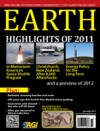 In the atmosphere, soot traps heat like carbon dioxide does. But unlike CO2, soot stays near its source and falls to Earth in weeks, so it’s considered low-hanging fruit in the fight against global warming. The first step to reducing atmospheric soot is to find it, which scientists have been doing since the 1980s with a particle-measuring tool called an aethalometer. Continue reading The Soot Surveyor
In the atmosphere, soot traps heat like carbon dioxide does. But unlike CO2, soot stays near its source and falls to Earth in weeks, so it’s considered low-hanging fruit in the fight against global warming. The first step to reducing atmospheric soot is to find it, which scientists have been doing since the 1980s with a particle-measuring tool called an aethalometer. Continue reading The Soot Surveyor
Tag Archives: Planetary science
Carbon Sampling Takes Flight
 Last month, aerial photographer and biologist Matevž Lenarčič flew a single-seat airplane across 2000 kilometers of airspace between Easter Island and Totegegie Airport in French Polynesia (right). That lonesome leg was one hop on a 3-month journey around the world, during which Lenarčič and his tiny, lightweight aircraft, a Pipistrel Virus (inset), also touched down on Antarctica, a rare solo feat. Between piloting the plane and collecting photographs for an upcoming book on water, Lenarčič has also collected data on black carbon, or soot, concentrations in the atmosphere. His 290-kilogram plane carries a much-lighter-than-normal Aethalometer, designed by aerosol scientist Griša Močnik of Aerosol in Ljubljana, Slovenia, that measures the optical absorption of the atmosphere and converts it to a rough estimate of soot concentration. Continue reading Carbon Sampling Takes Flight
Last month, aerial photographer and biologist Matevž Lenarčič flew a single-seat airplane across 2000 kilometers of airspace between Easter Island and Totegegie Airport in French Polynesia (right). That lonesome leg was one hop on a 3-month journey around the world, during which Lenarčič and his tiny, lightweight aircraft, a Pipistrel Virus (inset), also touched down on Antarctica, a rare solo feat. Between piloting the plane and collecting photographs for an upcoming book on water, Lenarčič has also collected data on black carbon, or soot, concentrations in the atmosphere. His 290-kilogram plane carries a much-lighter-than-normal Aethalometer, designed by aerosol scientist Griša Močnik of Aerosol in Ljubljana, Slovenia, that measures the optical absorption of the atmosphere and converts it to a rough estimate of soot concentration. Continue reading Carbon Sampling Takes Flight
Field hospitality
 Early in his career, Paul Olsen sat in front of a television, expecting to see his own image. He had hosted a television crew on a research expedition to Manicouagan Crater in Canada, where he and his team were investigating the Triassic–Jurassic boundary in the geological record. Olsen, a palaeontologist at Lamont–Doherty Earth Observatory of Columbia University in Palisades, New York, had spent hours explaining and re-explaining for the camera how scientists used the site to reconstruct ancient ecologies. As the opening credits rolled, Olsen wondered how he would come across on the small screen.
Early in his career, Paul Olsen sat in front of a television, expecting to see his own image. He had hosted a television crew on a research expedition to Manicouagan Crater in Canada, where he and his team were investigating the Triassic–Jurassic boundary in the geological record. Olsen, a palaeontologist at Lamont–Doherty Earth Observatory of Columbia University in Palisades, New York, had spent hours explaining and re-explaining for the camera how scientists used the site to reconstruct ancient ecologies. As the opening credits rolled, Olsen wondered how he would come across on the small screen.
Mantle Recycles Far Faster Than Thought
 The magma that rises from the mantle, forming new islands, may blast more than it bubbles. Where those plumes of magma originate — at the core-mantle boundary or the mantle-crust boundary — and how fast they rise to the surface are still open questions among volcanologists. But now a new study of minerals from the volcano Mauna Loa on the Big Island of Hawaii suggests that some elements made a 2,900-kilometer-long journey from the core-mantle boundary to Earth’s surface in as little as half a million years — quadruple the speed found by previous studies. Continue reading Mantle Recycles Far Faster Than Thought
The magma that rises from the mantle, forming new islands, may blast more than it bubbles. Where those plumes of magma originate — at the core-mantle boundary or the mantle-crust boundary — and how fast they rise to the surface are still open questions among volcanologists. But now a new study of minerals from the volcano Mauna Loa on the Big Island of Hawaii suggests that some elements made a 2,900-kilometer-long journey from the core-mantle boundary to Earth’s surface in as little as half a million years — quadruple the speed found by previous studies. Continue reading Mantle Recycles Far Faster Than Thought